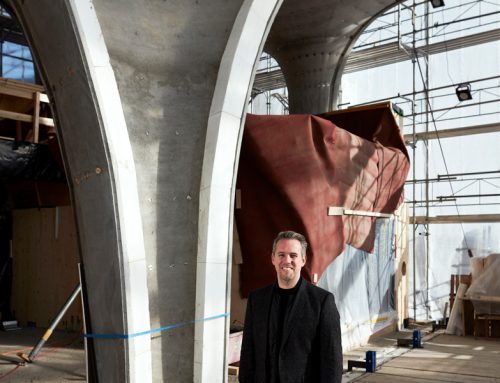 Beads are beautiful, aesthetic and one of the first expressions of human thinking. The oldest known beads in the world were found in the Blombos Cave on South Africa’s southern Cape coast. They date back 75 000 years ago when a human being walked the beach, collecting 60 shells of the same size, which were then strung together to make the world’s first bead necklace.
Beads are beautiful, aesthetic and one of the first expressions of human thinking. The oldest known beads in the world were found in the Blombos Cave on South Africa’s southern Cape coast. They date back 75 000 years ago when a human being walked the beach, collecting 60 shells of the same size, which were then strung together to make the world’s first bead necklace.
It was found about 20 years ago by a team of archaeologists and is regarded as the first expression of symbolic thinking and a concept of self. It sounds simple today, but all those years ago, someone had to make a leap in thinking to come up with the idea of stringing the shell beads together to make a pretty necklace. The necklace was clearly worn around someone’s neck because the beads show the kind of wear that is consistent with friction from rubbing against thread, clothes or other beads.
Since that time beads have been an important part of personal adornment and spiritual symbolism in Africa, later becoming a key form of trade currency between the people of Africa, Europe and Asia.
Following this tradition, Taryn Lamberti of Bead, has been sourcing the most fascinating collection of beads, old and new, from all over Africa: ostrich shell beads, sea shell beads, coconut shell beads, seeds, stones, bones, crystals, copper coins and Venetian glass beads brought by European traders to Africa hundreds of years ago.
At her design studio in Benmore, Sandton, Lamberti has a team of four highly skilled women crafters who create beautiful designs with the beads and sew them onto cushions. They dye the hemp linens, cotton velvets and other fabrics used in the cushions at the studio, using hand dyeing, dip dyeing, tie dyeing and bleach painting techniques. Each cushion is a unique work of art.
“The creative African use of beads and their significance in African culture and rituals, inspired our cushion collections,” says Lamberti. The collections have appropriate names, such as the Trade Routes Collection, and Medina Collection – inspired by the motifs on the studded doors of Tunisia.
The Bead team frequently works with interior designers who either
commission a cushion collection for a client’s home or for hotels and lodges. Bead also supplies the Conran shop in London (a high-end design store) and decorators in the United States and Australia.
“Our cushions are individually made, there is nothing mass produced about them,” says Lamberti. “If people want to buy one cushion or a whole range, each cushion is treated with the same care and dedication to design. We also use embroidery on some of the cushions, which is another wonderful form of African art that we want to keep alive.”
Everyone who visits the studio comments on the vibrancy and positive atmosphere. Everywhere you look you see bright fabrics and beads. The team has worked together for eleven years and gets on extremely well.
Bridgette Khalane is Bead’s expert dyer, planner and quality controller. Lorah Phampa is a master beader with an outstanding sense of colour. She is also the team’s resident DJ with a radio by her side, selecting talk shows and music, mainly on Khaya FM and Metro, throughout the day. Sue Mabaso is another master beader who keeps the production momentum going. Grace Ndlovu is a superb seamstress with a fashion industry background.
“We see ourselves as master crafters and each cushion is a tribute to Africa’s rich trading and cultural heritage,” says Lamberti. The Department of Trade & Industry has approached Bead to exhibit for South Africa at the Ambiente Trade Fair in Frankfurt in February 2012. “We are waiting to hear from them; it would be an incredible opportunity,” says Lamberti.
BOWLS AND BEAUTIFUL THINGS
Lara Tatley of togu’na knows the history of all the beads, bowls and beautiful things featured at her African artefact dealership in Jan Smuts Avenue, Parktown North, Johannesburg.
She has a direct link with Lamberti as she supplies her with African trade beads, such as traditional brass beads from the Baule tribe in Ivory Coast.
“Very old trade beads are highly valuable, such as the Islamic trade beads, handmade from glass a few thousand years ago, which have been excavated,” says Tatley.
What she likes about authentic, traditional African artifacts like beads or bowls is that “they have their own life” because they were worn or used, and are still worn or used in parts of the continent today.
Take bowls, for example, she explains. “People handled these bowls, prepared meals in them, washed them, re-used them and fixed them when they developed cracks with leather or metal stitching. They weren’t just thrown away, and because of this they have a beautiful worn or aged quality, with a patina or shine from being handled and from the oils used in the preparation of food.”
She also likes their shapes and describes the oval bowls of the traditional Turkana people of Kenya, made from a light-coloured wood. They are put into water to soften the wood, and a leather strap is then fastened around the girth of the bowl. As the leather strap shrinks, it pulls in the sides of the bowl so that the sides bend inwards, to make a container that is better suited to prevent spillages. These bowls also have a hole on one side so that they can be tied to the cattle with a leather strap as the Turkana are semi-nomadic and move with their cattle.
Regrettably, these bowls are becoming increasingly scarce because the Turkana today prefer plastic or tin, which is now readily available and lighter in weight. “Many of the Turkana and other traditional people of Africa today aspire to western culture, which is unfortunate because their unique traditions die out with this,” says Tatley who has seen a decrease in the number of authentic African utilitarian artifacts over the past couple of years.
“You get plenty of mass produced replicas for the tourist market, but the real thing is not easy to find, not only because of westernisation but also because many of Africa’s indigenous forests have been logged and destroyed.”
One of her favourite wooden bowls, which is actually more of a tray, is the Ethiopean ‘enjera’ tray, which is used for communal eating. “The enjera is a huge pancake which is served on a tray, which can be 50-80cm in diameter. All sorts of sauces are dolloped onto the enjera. A second enjera is then rolled up like a swiss roll, broken into pieces and used to mop up the sauces. “Everyone sits round the enjera tray and partakes of the meal,” says Tatley. “What is also interesting about these trays is that the underside has a beautiful, carved pattern; it is designed to be decorative when it is hung up after use.”
In addition to bowls, Tatley has an extraordinary range of beautiful African things, old and new, including sculptures, chairs, headdresses, anklets, currency, weapons, cloth, containers, head rests, stools and masks.
To keep African artistry alive she works with craftspeople, such as an artistic community in Foumban, Cameroon who carve the legendary Bamileke stools. “They are very good carvers but they tend towards mass production,” says Tatley. “I am working with them to show them that if they carve with more care their carvings will be more desirable. I do the same with the traders with whom I do business in Africa, so that they too can think this way and encourage artists to make good, quality items.”




